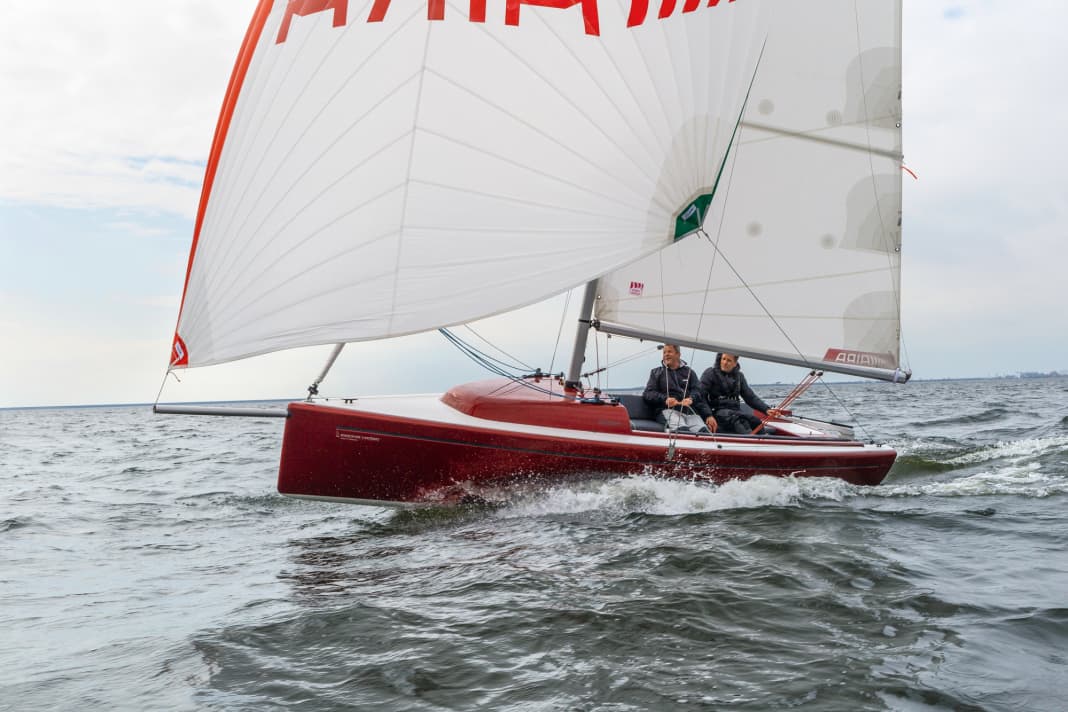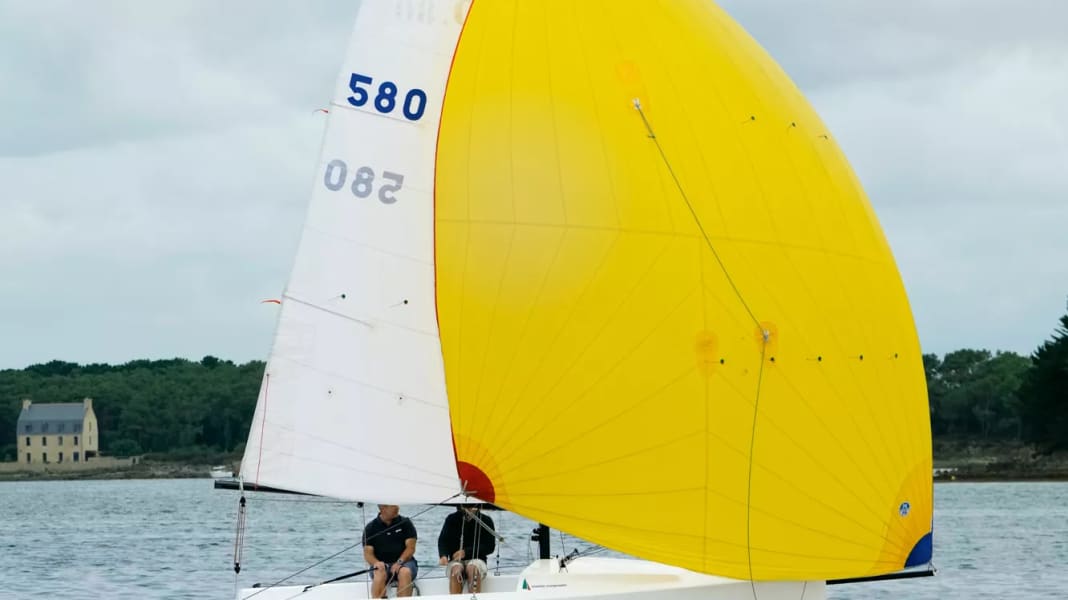
The Gulf of Morbihan is one of the best-known and most popular sailing areas on the French west coast. Here in Brittany, the Atlantic tides pump vast quantities of water twice a day through a narrow land passage into a widely ramified, almost unmanageable inland sea with more than 50 small islands. The tidal range averages four metres, the currents are unpredictable and nasty shallows are omnipresent. Anyone travelling here in a sailing boat needs in-depth knowledge of the area or at least a very precise nautical chart. A boat that can fall dry is almost a basic requirement, especially as most harbours run dry at low tide.
Accordingly, although the challenging waters are navigable for larger yachts, they are actually completely unsuitable. Instead, small sailing boats with variable draughts are popular and just right for the area: Dinghies, sports boats or small cruisers. The small but excellent shipyard Marine Composite in Arzon, located directly on the Gulf of Morbihan, is one of the suppliers of this type of boat. Since 1996, shipyard boss Bertrand Aumont and a handful of employees have been building small GRP boats that meet the requirements of the area with pinpoint accuracy. The small and extremely attractive La Gazelle gaff-rigged boats are well known, and Marine Composite has already built and delivered more than 80 of them - most of them right on its own doorstep.
Designed by the ocean racing yacht designer
With the Bihan 6.50 the shipyard presented a modern version of the Gazelle concept in 2016, also with a gaff rig, swing keel and a small cabin with two single berths. The boat has also sold very well. After all, 35 of them are already in use. A great success for the shipyard.
The new, slightly smaller Bihan 5.80 is now set to surpass this. As with its sister model, the design comes from the Finot-Conq studio in Vannes, which is known for its fast ocean racing yachts and is located on the Gulf of Morbihan. No wonder that chief architect David de Premorel also has his boat there. From a regional perspective, the circle is complete.
The Bihan 5.80 in detail:
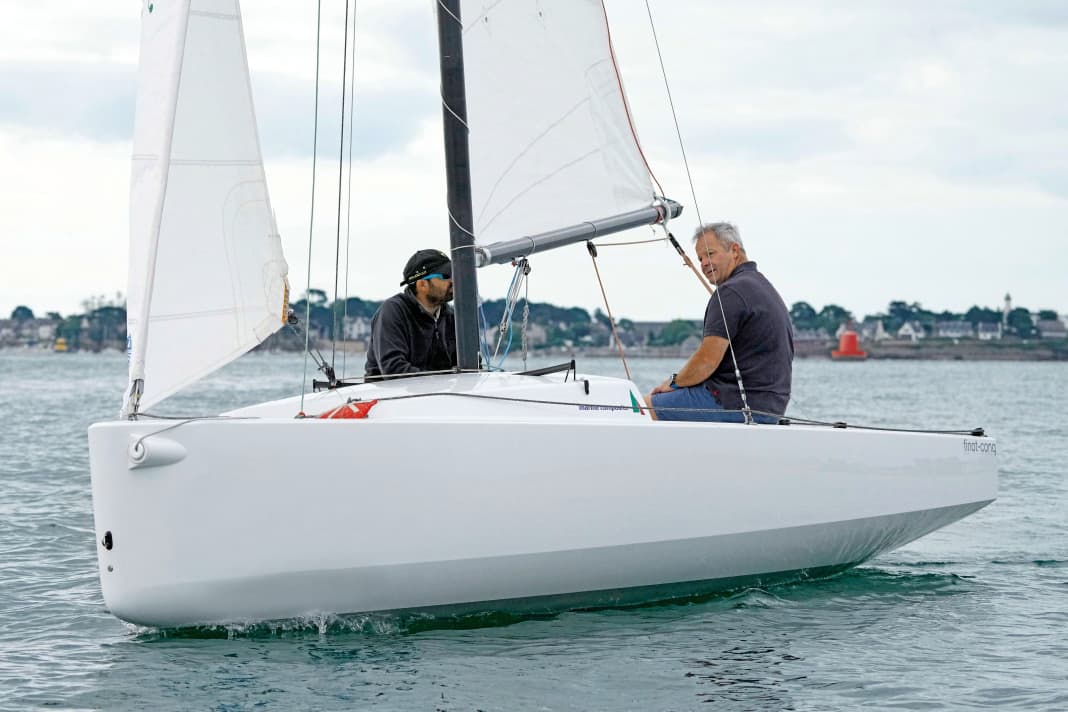





The brand's DNA remained unchanged in the new development: The Bihan 5.80 also carries a gaff rig and has retractable hull appendages. This allows it to be launched and retrieved like a dinghy via the slip ramp, as its swivelling keel disappears almost completely into the hull in the upper position.
Only about five centimetres of the fin protrude from the keel box - a kind of grounding protection when landing on the beach to prevent damage to the GRP floor. The Bihan is designed to fall dry, even regularly in tidal waters. The structures have been specially dimensioned for this purpose.
The rig is unusual, but effective
The more distinctive feature, however, is the type of rigging. To describe the Bihan in a few words, the characterisation "the one with the gaff rig" suffices. In fact, it stands out from the competition of sports boats and small cruisers. Shipyard boss Bertrand Aumont assembles the rigs for all his boats himself. And he makes it quite easy for himself and his customers: for the mast, gaff and main boom, he uses simple round carbon fibre tubes of various diameters, which he buys by the metre and cuts to length.
The simple and inexpensive production is only one advantage of the supposedly antiquated gaff rig. More decisive is its very good trimmability. If you know how to handle the peg and claw, you can adjust the sail profile and the tension on the leech very precisely. If this is successful, the gaff size is in no way inferior to the performance of a conventional sail on a conventional mast, especially as the carbon tubes also help to limit the top weight.
And there is another plus point: if the wind picks up for a short time, you can take a lot of pressure off the mainsail by simply unfurling the furling line a little; this opens the leech very effectively. This means you can delay the more time-consuming task of tying in a reef.
Despite all the functional and visual advantages, the shipyard also offers a conventional high rig for the Bihan 5.80 as an option, which is also wrapped in carbon fibre.
Sophisticated hull design and clever details
The mast of the Bihan 5.80 is positioned relatively far back in the boat. This means that the furling jib can be moved over a self-tacking rail on the foredeck and still be reasonably large. Single-handed sailing is therefore no problem with the little Frenchwoman. In addition, the gennaker is operated from a so-called trumpet, i.e. from a channel built into the foredeck with a large opening in the foredeck. The gennaker halyard, the jib line and the bowsprit outhaul line are linked so that the 30 square metre space windsail can be set and recovered with a single end. With a little practice, even soloists can manage it well.
Whether single-handed, sporty or cosy with the family - the Bihan is suitable for a wide range of uses
If you prefer to sail with a crew, you can invite up to three additional crew members. The cockpit is large enough for everyone to find enough space on the high edge. Foot straps are fitted as standard to provide support when travelling. The Bihan can also be optionally equipped with a railing.
Bihan 5.80 de facto "unsinkable"
Unfortunately, the weather had little spectacular to offer for the tests on the Gulf of Morbihan. It was blowing lightly at between 6 and 8 knots, which meant that the small boat was travelling at a speed of 4.8 knots with a tacking angle of 90 degrees, measured at a time when the tide was just capsizing and the current was therefore weak. With a gennaker, the sail dwarf, which weighs only 560 kilograms, reaches a good 6 knots. Erwan Gourdon, the man responsible for the design of the Bihan 5.80 at Finot-Conq, credibly reports planing speeds of up to 15 knots under gennaker in much stronger winds.
Despite the wide stern and flat frame, the design manages with only one rudder blade attached at the rear. This gives a good feel at the tiller extension. The boat can be steered precisely with little pressure. It has something of dinghy sailing about it. In any case, it is easy to quickly bring the Bihan up to its performance potential.
All Marine Composite boats are built and equipped entirely in Arzon. The hull and deck are produced as GRP sandwich constructions using a complex but weight-saving vacuum infusion process with polyester resin. The channel for the gennaker is installed as a separate, completely sealed component. The foredeck on the starboard side remains accessible as storage space for equipment, outboard motor and personal items and is sealed with a hatch. This makes the boat de facto unsinkable, even though this designation no longer exists as a standard.
Simple keel reduces costs
In the construction of the swing keel, the shipyard makes it easy for itself and installs a non-profiled steel plate with lead ballast bodies bolted to the bottom.
For designer Gourdon, the lack of profiling on the keel does not play a decisive role in terms of lift and performance for boats of this size. At the same time, the shipyard admits to being able to save costs with this very simple keel design; this advantage is passed on to the buyer.
With a basic price of 34,710 euros including a simple but complete set of sails, the Bihan 5.80 is not exactly a bargain. However, if you take into account the high-quality and robust construction as well as the good basic equipment, it appears to be very fairly priced. The overall package certainly makes a harmonious impression, and the amount of individuality also makes the Bihan highly attractive. Anyone interested in a small, sporty and trailerable boat should definitely take a closer look at the gaff construction from the Golf du Morbihan.
Yacht rating Bihan 5.80
Attractive and versatile concept between daysailer, touring and sports boat. In the test, the construction shows impeccable performance in light winds and promises a lot of sailing fun even with more pressure. The GRP work is convincing and the rig makes the Bihan an exceptional model.
Design and concept
- + Fancy, pretty boat
- + Trailerable and suitable for the beach
- - High but reasonable price
Sailing performance and trim
- + Very sporty sailing performance
- +Good one-handed suitability
- +Dinghy-like properties
Equipment and technology
- + Wide catch-up keel
- + Lightweight carbon fibre rig
- - Non-profiled keel shaft
Technical data Bihan 5.80
- Design engineer: Finot-Conq
- CE design category: C
- Torso length:5,80 m
- Total length:6,80 m
- Waterline length: 5,50 m
- Width:2,20 m
- Draught (swivelling keel):0,20-1,50 m
- Mast height above waterline:14,0 m
- Theoretical torso speed: 6.2 kn
- Weight:560 kg
- Ballast/proportion:186 kg/33 %
- Mainsail: 14,0 m²
- Self-tacking jib: 7,0 m²
- Gennaker: 30,0 m²
- Motor (outboard): 2.3 hp/electric
Sailing performance
without drift/current; wind speed: 6 to 8 kn (2-3 Bft), wave height: smooth water
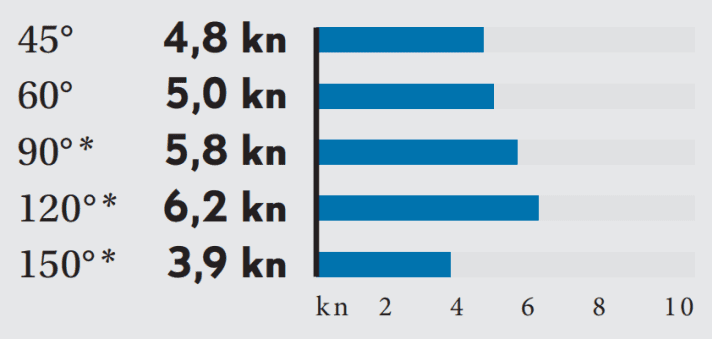
Potential STZ1 = 5.6

The small Bihan 5.80 is quite light. The sail area is not generous, but still sufficient
Hull and deck construction
GRP sandwich construction with foam core (Airex), built using the vacuum infusion process with polyester resin
Rig and sail
Gaff rig made of carbon fibre as standard, plus self-tacking jib. A single set of sails (main and jib made of Dacron) and the gennaker are included in the scope of delivery
Keel and rudder
Swivelling keel with a single steel fin and a bolted lead ballast section. The rudder blade is attached at the rear and can be raised
Motorisation
Outboard motor (petrol) with up to 6 hp. Electric outboards are also possible as an option. The drives can be stored in the storage space in the foredeck
Equipment and prices
- Base price ex shipyard: € 34,710
- Price ready to sail: € 37,170
- Warranty/against osmosis: 2/2 years
Shipyard and distribution
Marine Composite, 56640 Arzon (France); www.marine-composite.fr
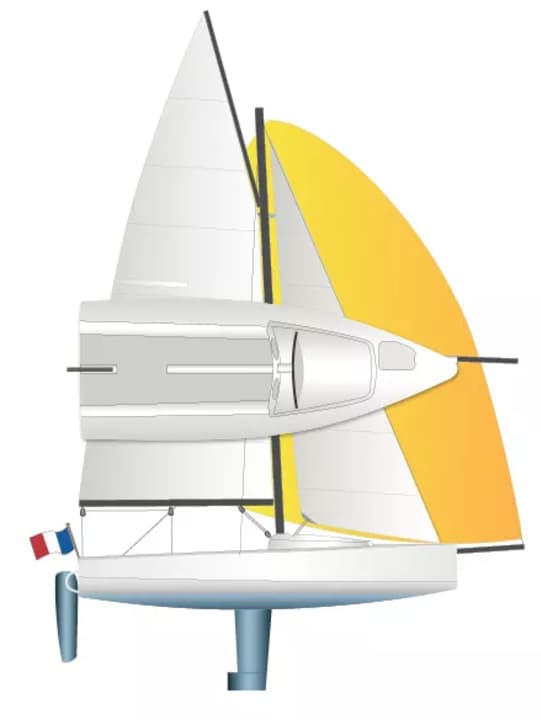
Small, sporty and not only suitable for regattas: the competition of the Bihan 5.80
